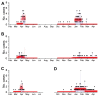Transmission Potential of Influenza A(H7N9) Virus, China, 2013-2014
- PMID: 25897624
- PMCID: PMC4412215
- DOI: 10.3201/eid2105.141137
Transmission Potential of Influenza A(H7N9) Virus, China, 2013-2014
Abstract
To determine transmission potential of influenza A(H7N9) virus, we used symptom onset data to compare 2 waves of infection in China during 2013-2014. We found evidence of increased transmission potential in the second wave and showed that live bird market closure was significantly less effective in Guangdong than in other regions.
Keywords: China; H7N9 virus; infectious disease reservoir; influenza; viruses.
Figures


References
-
- Lau M, Wei L. Guangzhou begins trial ban of live poultry sales after H7N9 wet market tests. South China Morning Post. 2014. May 5; News/China/Health.
Publication types
MeSH terms
Grants and funding
LinkOut - more resources
Full Text Sources
Other Literature Sources
Medical

